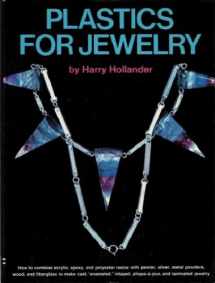
Plastics for Jewelry: How to Combine Acrylic, Epoxy, and Polyester Resins with Pewter, Silver, Metal Powders, Wood and Fiberglass to Make Cast, "Enameled," Inlayed, Plique-a-Jour & Laminated Jewelry
ISBN-13:
9780823040278
ISBN-10:
0823040275
Author:
Harry Hollander
Publication date:
1974
Publisher:
Watson-Guptill Publications
Format:
Hardcover
207 pages
FREE US shipping
Book details
ISBN-13:
9780823040278
ISBN-10:
0823040275
Author:
Harry Hollander
Publication date:
1974
Publisher:
Watson-Guptill Publications
Format:
Hardcover
207 pages
Summary
Plastics for Jewelry: How to Combine Acrylic, Epoxy, and Polyester Resins with Pewter, Silver, Metal Powders, Wood and Fiberglass to Make Cast, "Enameled," Inlayed, Plique-a-Jour & Laminated Jewelry (ISBN-13: 9780823040278 and ISBN-10: 0823040275), written by authors
Harry Hollander, was published by Watson-Guptill Publications in 1974.
With an overall rating of 3.6 stars, it's a notable title among other
books. You can easily purchase or rent Plastics for Jewelry: How to Combine Acrylic, Epoxy, and Polyester Resins with Pewter, Silver, Metal Powders, Wood and Fiberglass to Make Cast, "Enameled," Inlayed, Plique-a-Jour & Laminated Jewelry (Hardcover) from BooksRun,
along with many other new and used
books
and textbooks.
And, if you're looking to sell your copy, our current buyback offer is $0.3.
Description
This book shows how to combine acrylic, epoxy, and polyester resins with traditional jewelry materials and techniques to make jewelry that is distinctive, imaginative, and beautiful.The author, one of the most knowledgeable and innovative voices in the field of plastics today, demonstrates how to make a wide variety of jewelry including pendants, pins, rings, earrings, necklaces, cufflinks, bracelets, and belt buckles. The unique characteristics of each of the three resin systems -- acrylic, epoxy, and polyester -- are explained in detail. Then, in a series of projects that provide lists of materials, specific formulas with mixing instructions, and step-by-step illustrations accompanied by detailed captions, the author shows how each can be used to its fullest advantaqe. Acrylic resins are combined with heat-formed acrylic to make pendants and rings, used as "paints" in relief painting, mixed with other media in earrings, and used in the rotational casting of necklaces with antique-glass-like surfaces. Epoxy resins are used as "enamels" for casting metalized pendants, sterling silver plique-à-jour rings, wooden earrings, and bas-relief pendants; as "jewels" for earring fittings; and as glues for inlaying pewter in a ring and for fashioning a slate and pewter pendant. Polyester resins are used for casting, pouring, and swirling a necklace, for laminating earrings with pewter, and for making cufflinks, pearlescent bracelets, and belt buckles with fiberglass reinforcement. In addition, precise formulas are given for making pewter and for preparing releasinq and non-releasing molds from materials such as Silicone rubber, wax, soapstone, and glued acrylic sheet. The text is illustrated with over 300 halftones and 46 full color plates, including innovative jewelry by leading craftsmen from many countries. A large glossary of terms plus an annotated suppliers and manufacturers list of both plastic and jewelry-making materials round out this handsome volume.


We would LOVE it if you could help us and other readers by reviewing the book
Book review

Congratulations! We have received your book review.
{user}
{createdAt}
by {truncated_author}


